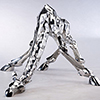Catalogue Note:
Born in the 1970s, Li Hui is one of the leading figures in the younger generation of Chinese sculptors; his work has been exhibited all over the world, and is widely collected. Li Hui has grown up during three decades in which China has developed more rapidly than at any time in the past, and has witnessed dramatic transformations and also the harm caused by sudden change. Most artists of the generation to which Li belongs have focused on the changing times and the sense of alienation of the individual; Li’s art focuses mainly on people’s psychological states, and in particular on feelings of insecurity. He excels at combining materials and concepts in effective ways, and makes extensive use of modern technology in his work, which enables him to express a unique technological aesthetic. Li attempts to show conflict between the themes of his work and the materials used to create the work, as a means of pointing up the social contradictions that exist in contemporary China.
“Giraffe – Camouflage for the Industrial Era” has an exhausted-looking giraffe as its subject matter. The piece uses stainless steel to challenge people’s conventional visual experience. With its deep conceptual underpinnings and innovative, experimental techniques, this work symbolizes the conflict between industrial civilization and the natural environment, but also gives the viewer a visual and spiritual shock. The huge giraffe is shown resting its tired body on the ground; the mirror-like surface of the surrounding stainless steel reflects the image of the viewer, so that, in the process of examining the work, the viewer is also drawn into it. This combination of a bright, attractive surface and a tired, weary body constitutes a faithful depiction of countless urbanites; while looking at someone else, one is also pursuing one’s own reflection as reflected in their body. The “camouflage for the industrial era” is thus actually the two-way reflection of the soul.
“Giraffe – Camouflage for the Industrial Era” has an exhausted-looking giraffe as its subject matter. The piece uses stainless steel to challenge people’s conventional visual experience. With its deep conceptual underpinnings and innovative, experimental techniques, this work symbolizes the conflict between industrial civilization and the natural environment, but also gives the viewer a visual and spiritual shock. The huge giraffe is shown resting its tired body on the ground; the mirror-like surface of the surrounding stainless steel reflects the image of the viewer, so that, in the process of examining the work, the viewer is also drawn into it. This combination of a bright, attractive surface and a tired, weary body constitutes a faithful depiction of countless urbanites; while looking at someone else, one is also pursuing one’s own reflection as reflected in their body. The “camouflage for the industrial era” is thus actually the two-way reflection of the soul.



